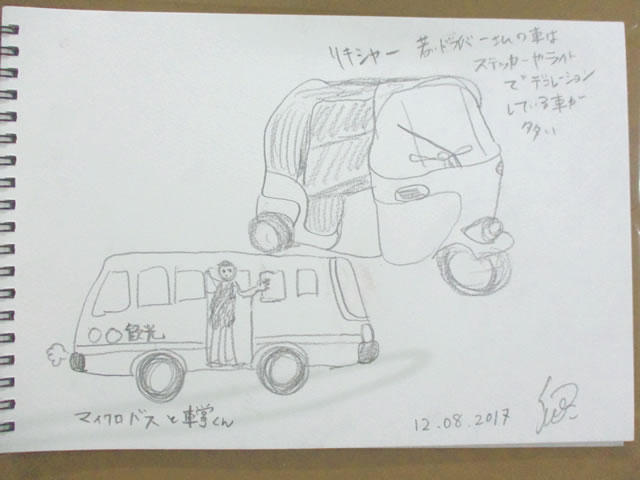[Original by Takahiko HASHIMOTO, Sudan Project (October 10, 2017); Translated by K. Adachi/A. Senkoff]
Hello to everyone who are supporting JVC. This is Hashimoto. For the past few days, it has been heavily raining in Khartoum. I had made a mistake in the past by underestimating the rain in Sudan after believing it only rained a little bit. The sky became dark suddenly and it began to rain heavily after lightning. In addition, a blackout happened. Next day the room that was being used as office became flooded. The area around the building was also flooded and was similar to a pond so I couldn’t go out for a while.
Traffic situation in Sudan
This time I will report about the traffic situation in Sudan. The way people travel in Sudan is with a car. Although a train appeared to be running previously, nowadays there is no train running for passengers as it only serves cargos. The transportations options, arranged based on cheaper fees, are microbus, HIACE (minivan of Toyota), rickshaw, a light van called “amjad” and an ordinary yellow taxi.
A microbus is similar to a scheduled bus in Japan with regular routes but it can also stop at certain places if someone raises their hand. There is no display of destination on the bus. Instead, a young guy, who acts as a conductor on the bus, stands at the door and indicates to people on the street whether the bus is going straight or turning by using his hands. When passengers are on the bus, the conductor collects the fare by snapping fingers. I am impressed that the conductor always remembers which persons have already paid the fare, although a number of passengers are getting on or getting off the bus. The fare is about 2-3 SDG (Sudanese pound) depending on the destination (the exchange rate in bank and in town is greatly different in Sudan, 1 USD equals 7 SDG in the bank but it could be 20 SDG in the town). In Japan, passengers press a buzzer to stop the bus. In Sudan, passengers whistle or snap their fingers to tell the conductor to stop the bus. Then the conductor tells the driver by whistling again. Buses are sometimes equipped with TV, which shows Sudanese comedy, drama or professional wrestling for entertaining the passengers.
HIACE is modified to accommodate 8 to 10 passengers by installing auxiliary seats. This runs on regular routes as well, and works the same way as microbus regarding how passengers stop and get off the vehicle. The fare is 5 SDG. By the way, both of microbus and HIACE are second hand cars. Most of them are made in China or Korea but sometimes you can find Japanese cars with the words such as “XX Sightseeing” or “YY Rental Car” painted on the side.
At bus terminals, where many buses leave and many passengers gather, the competition for conductors to catch passengers is very fierce. The voices that repeat the destinations for each bus sound just like what you would find at an auction in the market. The conductors are desperate because the bus cannot leave unless it’s almost filled with passengers. Rickshaw is the familiar tricycle in South-East Asia. The fare from this category is negotiable. The negotiation starts when you tell the driver the destination before you get in. I begin negotiation by saying “I got it with this fare last time…” (I don’t tell a lie). Usually, the negotiation is settled at the halfway point of the requests made by the driver and the passenger. The area a rickshaw can operate is limited, and the fare is usually between 10 to 40 SDG. Sometimes the driver picks an acquaintance up along the way and passengers share the ride together. Drivers say “Let him ride too because we are going to the same direction.” Amjad is a light van, which is convenient when you travel with a lot of baggage or with several people. I usually use it on the way to go and from the airport. It costs about 60 to 80 SDG.
In addition to the above vehicles, there are buses showing bus stops and destinations as well as long-distance buses. I will introduce them next time because I have not used them yet. Sudan is a car-run society and is not sympathetic to pedestrians. The majority of the pavements are sand (I had muscle pains after walking for the first month), and there are often big holes in the ground. Pedestrian crossings are only at large road intersection. You have to have a lot of courage to go into the flow of cars and cross the road by observing the flow of traffic. At first I thought “Definitely impossible!” but once I was getting used to it, I found out that drivers drive cars at moderate speeds due to the large number of people crossing the road. I’m lately getting pretty brave by stopping cars with my hand and crossing the road. Oh, and on a finale note, there are also many donkeys working hard to pull carts within this society dominated by automobiles.
Share This:
